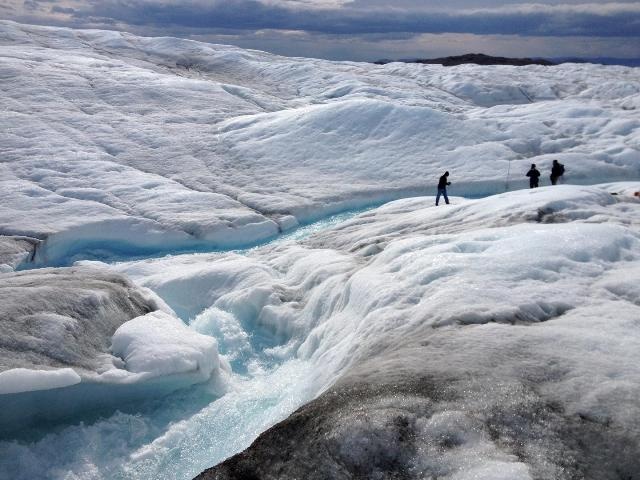Jun 10 2016
A new study provides the first evidence that links melting ice in Greenland to a phenomenon known as Arctic amplification--faster warming of the Arctic compared to the rest of the Northern Hemisphere as sea ice disappears.
 Researchers including the University of Georgia's Thomas Mote measure meltwater runoff from the ice sheet margin in Greenland during summer 2013. (CREDIT: Courtesy of Thomas Mote/University of Georgia)
Researchers including the University of Georgia's Thomas Mote measure meltwater runoff from the ice sheet margin in Greenland during summer 2013. (CREDIT: Courtesy of Thomas Mote/University of Georgia)
The findings show that the predicted effects of Arctic amplification, as described in previous studies, occurred over northern Greenland during summer 2015, including a northern swing of the jet stream that reached latitudes never before recorded in Greenland at that time of year.
The study, published today in Nature Communications, included researchers from University of Georgia, Columbia University, University of Liege, City College of New York, University of Leeds and the University of Sheffield.
The Greenland ice sheet, Earth's second largest after Antarctica, holds enough ice that if it were to melt entirely, it would raise average global sea level by about 7 meters, or almost 23 feet. Learning more about the drivers of melting is essential to discerning how much sea level will rise and by how much in the future and how Greenland's freshwater runoff will affect ocean circulation and ecology.
"During the past two decades, we have seen increasing melt from the Greenland ice sheet, culminating in a very large melt event in the summer of 2012," said study co-author Thomas Mote, a University of Georgia professor in the department of geography. "Last year was unique in the extensive melting that occurred on the northern reaches of the ice sheet, an area that usually has rather modest melt compared to southern Greenland. We identified an unusual configuration of the jet stream toward northern Greenland that led to this melt pattern."
Rising global temperatures are melting Arctic sea ice, leaving dark open water that absorbs more solar radiation and causes faster warming in the Arctic. While Arctic amplification is well documented, its effects on the atmosphere are still debated. One theory among scientists is that the shrinking temperature difference between the Arctic and the temperate zone will lead to a slowing of the jet stream. Normally, when the jet stream circles the northern latitudes, the frigid polar air is separated from warmer air in the south. Slower winds, however, could create wilder swings that would allow warm, humid air to penetrate farther north.
"The Greenland ice sheet is one of the most important contributors to sea level rise since 2000," Mote said. "Moreover, some recent work has shown how meltwater runoff can affect ocean productivity and circulation in southern Greenland. However, we don't yet have a good understanding of how increased melt in the north might affect surrounding oceans and the dynamics of the ice sheet."
Northwest Greenland's summer melt started last June when a high-pressure ridge squeezed off from the jet stream and moved westward over Greenland and hovered over the Arctic Ocean, the study shows. Clear skies and warmer weather in northern Greenland from this high-pressure system resulted in record setting surface temperature and meltwater runoff in the northwest. With less summer snow falling and melting underway, northern Greenland's reflectivity also decreased and the water absorbed more heat from the sun, further increasing melting.
Northern Greenland's wind patterns also changed from the usual west to east direction to east to west. Only two other years on record show east to west wind averages in July and both were slower. Further, the jet stream's northernmost ridge swung nearly 2 degrees farther north than the previous July record, set in 2009.
The same atmospheric pattern had a different impact on southern Greenland, where new melting records have been set over the past decade. The south saw more snow during summer 2015 and less melting than previous years.
"How much and where Greenland melts can change depends on how things change elsewhere on Earth," said the study's lead author Marco Tedesco, a research professor at Columbia University's Lamont-Doherty Earth Observatory and adjunct scientist at NASA Goddard Institute for Space Studies. "If loss of sea ice is driving changes in the jet stream, the jet stream is changing Greenland, and this, in turn, has an impact on the Arctic system as well as the climate. It's a system, it is strongly interconnected, and we have to approach it as such."
The authors don't fully confirm Arctic amplification as the cause of the warming, but say the results of their study fit the description of possible effects as predicted by other researchers. Whether the patterns seen in 2015 will continue in the future is uncertain. This spring, Arctic sea ice set another record low for its maximum extent for the year.
"Greenland also experienced early season melt in early April of this year comparable to April 2012. Record-setting melt occurred later that summer, but it is too early to tell whether the same will hold true in 2016," Mote said.